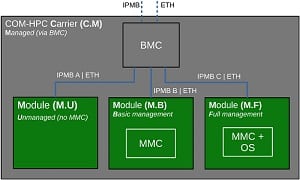The dedicated modular system management interface gives remote management access to embedded systems, OEMs and users

PICMG, a consortium for developing open embedded computing specifications has released the COM-HPC Platform Management Interface (PMI) specification. It provides a framework of remote and out-of-band platform management features for COM-HPC Computer-on-Module based edge computing designs and is freely available on the PICMG website.
COM-HPC is an open Computer-On-Module (COM) form factor standard for High-Performance Computing (HPC) that combines high-end I/O bandwidth with edge computing performance levels. Standard COM-HPC modules plug into an application-specific carrier board (aka baseboard) and offer OEMs an application-ready computing core to accelerate design cycles, reduce NRE costs and increase ROI as well as sustainability by extending longevity options beyond a certain processor family or module vendor.
“The dedicated modular system management interface, which gives remote management access to embedded systems – even out-of-band – is another industry first introduced by COM-HPC,” explains Christian Eder of congatec, the chairman of the COM-HPC committee. “Thanks to this feature, OEMs and users will be able to ensure highest levels of reliability, availability, maintainability and safety (RAMS) for their worldwide deployments of distributed network infrastructure equipment and edge/fog computing servers as well as IIoT gateways and clients. For individual needs, these COM functions can be expanded via an optional board management controller on the carrier board. This provides OEMs with a modular framework of uniform remote management functions that can be flexibly scaled to specific requirements.”
The COM-HPC PMI specification is a supplement to the COM-HPC open standard and serves as a guide on how to achieve interoperability between COM-HPC modules from different vendors and combinations of carrier boards. It adapts the Intelligent Platform Management Interface (IPMI) specifications to COM-HPC designs and also touches the implementation of Redfish features.
IPMI is a collection of side-band/out-of-band management commands that are used for system interaction. IPMI firmware generally runs on a board management controller, a discrete integrated circuit that is accessed via a network connection and/or serial interface and/or LPC/eSPI.
Redfish, a standard managed by DMTF, provides a Representational State Transfer (RESTful) interface for the management of systems. Redfish is still under active development, and it continues to evolve as new use cases are discovered.
The COM-HPC PMI document describes three different PMI maturity levels for modules and two for carrier boards. The modules’ PMI maturity levels range from unmanaged module (M.U) and basic managed modules (M.B) to fully managed modules (M.F), and carrier board levels range from unmanaged (C.U) to managed carrier boards (C.M). The goal of specifying these different levels is to allow interoperability between multiple modules and carrier board designs. The different module management capabilities are broken down by their adherence to a set of IPMI commands listed below.
The modular COM-HPC Platform Management Interface specification is available for download on the PICMG website.






